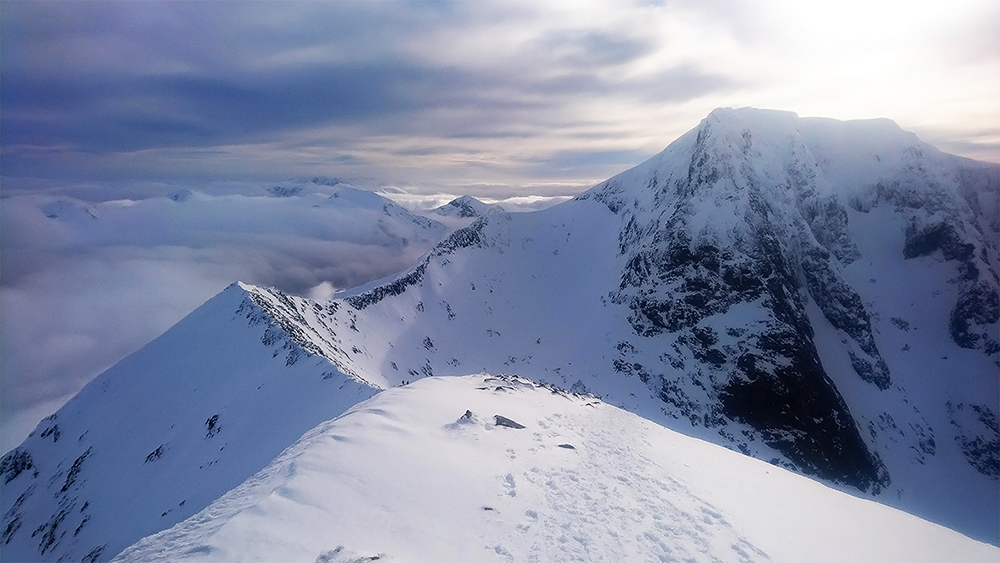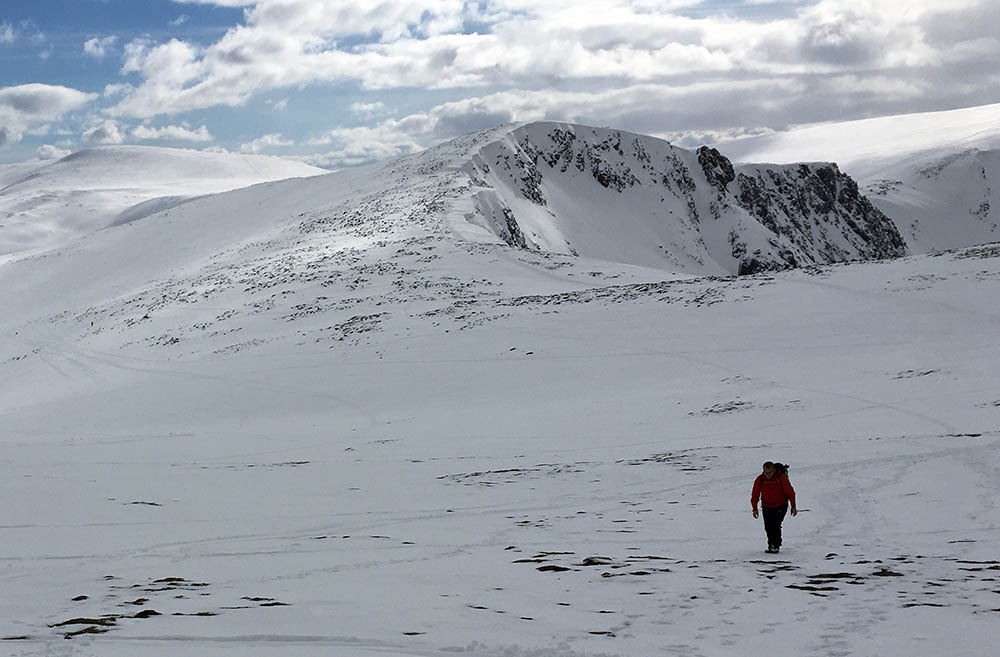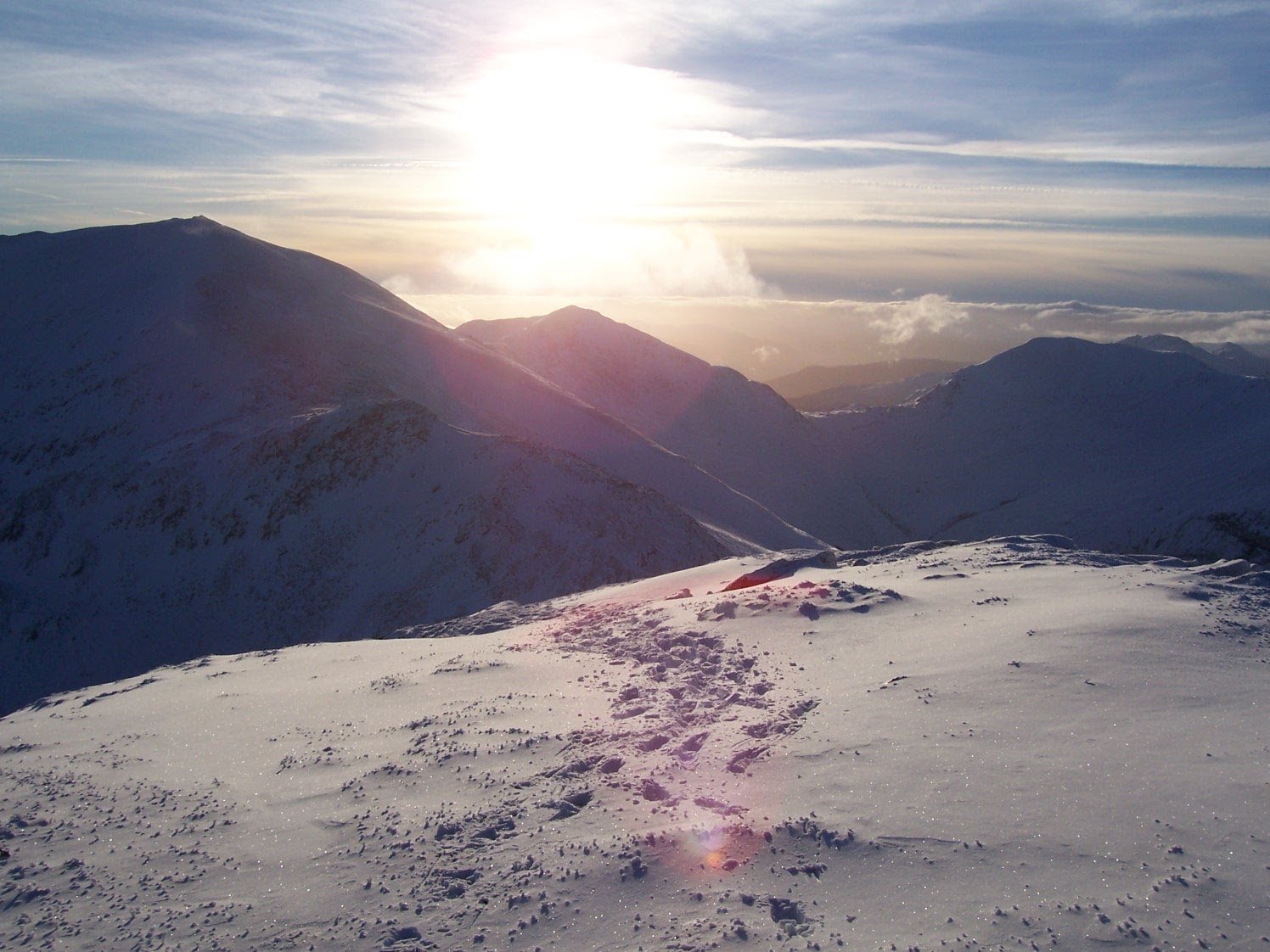Top Winter Mountaineering Destinations in the United Kingdom
As the Northern Hemisphere enters its winter months, many outdoor adventurers stow away their crampons and dust off the skis instead. The combination of short days, low temperatures, and bad weather make mountaineering at the very heart of winter a tall order.
While classic mountaineering destinations, including the Alps, temporarily fall out of reach, climbers should instead train their sights northwards. The much more modest peaks of England, Scotland and Wales present the perfect opportunity for climbing in the heart of winter.
Easily the most reliable destination of climbers headed to the United Kingdom during the winter months is the Scottish Highlands. Rising straight up from sea level, these modest but steep peaks boast great climbing terrain along with stunning views.
The smaller summits of England and Wales do not always receive adequate snowfall, though 2020 has been a particularly good year for them. Even so, the peaks offer some scenic views and make for great hillwalking.
For people looking to try out winter climbing for the first time, a mountaineering expedition in the UK is a great way to start. Conditions on the mountains are similar to those found at higher elevations during the summer season and allow climbers to learn all the necessary technical and safety skills.
Many guides offer weekend-long ascents of the most iconic peaks on the British Isles, complete with a day of learning all the necessary skills, before making the ascent on the following day.
For intermediate-level climbers, there are plenty of more challenging ascents to make as well. Both Ben Nevis and the Cuillin offer tougher climbing options. Ben Nevis boasts some excellent ice climbing, while a winter traverse of the Cuillin is widely considered to be the best alpine climbing experience in the UK.
Away from these two premier climbing spots, there are plenty of other great winter climbing options throughout the UK. Check out the top five spots below and begin planning your next winter mountaineering trip.
1| Ben Nevis

Reaching a modest 1,345 metres (4,413 feet) above sea level, Ben Nevis rises over the surrounding peaks in the Scottish Highlands. The remains of a Devonian volcano constitute the highest point in Scotland as well as the whole of the United Kingdom.
During the summer months, Ben Nevis is a popular hiking and climbing destination, with the easiest routes to the summit requiring no technical abilities. However, in the winter, Ben Nevis transforms into an imposing summit; one that is frequently enshrouded in cloud and battered by winter snow and wind.
As a result, the peak serves as a popular training ground for climbers headed on expeditions to the Alps or farther afield as well as the perfect place to head on a challenging ice or alpine climbing experience.
Keep reading: A Beginner’s Guide to Mountaineering
Most trips to Ben Nevis begin with a flight into Glasgow Airport (GLA). Some guides opt to meet here and arrange transport to the start of the trips, but most others will opt to meet closer to the peak. Renting a car and making the 2.5-hour drive to Ben Nevis is both scenic and simple.
As was previously foreshadowed, the weather is among the biggest challenges facing climbers that are heading up to the summit of Ben Nevis. Winters in Scotland feature short days and plenty of clouds and precipitation.
Ben Nevis is known for having particularly bad weather, which is part of why mountaineers use the peak to train for higher-altitude ascents. With low visibility being a near-constant challenge, route finding is a critical challenge – and an excellent learning opportunity – for novice mountaineers.
Away from the climate, making a winter ascent of Ben Nevis also requires technical snow and ice climbing on the vast majority of routes (though the normal route can be hiked). While all skills can be taught in the day(s) leading up to the summit, most guides recommend having previous winter hiking experience.
While the Tourist Route is the most popularly taken one in the summer, the numerous routes of the mountain’s famous north face are the most popular destinations for winter.
Composed of four main ridges, Tower Ridge is one of the most commonly climbed routes in the winter. Boasting AD+ level climbing, the route follows the long and exposed ridge on the northeast of Ben Nevis all the way to its summit.
The Curtain (Scottish winter grade IV/V), which is situated on the left side of the Càrn Dearg Buttress, is the most popular ice climbing route on the peak and offers a short but tricky water-ice ascent.
Quick facts:
- Location: Scotland
- Elevation: 1,345 m (4,413 ft)
- Duration: 2 to 3 days
2| Snowdon

Situated in the northwestern corner of Wales, Snowdon (Yr Wyddfa, in Welsh) rises high above the surrounding mountains, lakes and fields. Originally formed by volcanic activity half-a-billion years ago and since carved by glaciers, Snowdon is the nineteenth highest mountain in the UK and tallest outside of Scotland.
However, Snowdon is also the third most prominent and the incredible views from its summit – on clear days it is possible to see all the way across the Irish Sea as well as north to Scotland and east to England – have made it one of the most popular hiking and climbing destinations in the UK.
An estimated 500,000 people come to Snowdown each year to hike up the classic Llanberis path or try their hand at one of the more challenging scrambling or rock climbing routes. In fact, Edmund Hillary used the north face of Snowdon to train for his ascent of Mount Everest in the 1950s.
While the vast majority come during the peak summer months, the winter is the perfect time to come and make a more challenging ascent of the peak and practice the necessary mountaineering skills for tougher ascents in the Alps and beyond.
Despite being located in Wales, most trips to Snowdon will begin with a flight into Liverpool John Lennon Airport (LPL). From here, it is easiest to rent a car and make the two-hour drive east to Snowdon.
During the summer months, Snowdon is a fairly easy peak to climb and requires no technical ability. However, in the winter, the climb is more challenging and may require some snow climbing experience as well as proper mountaineering equipment.
Away from technical difficulties, climbing Snowdon presents various climatic challenges as well. Even the easiest routes up to the summit of the mountain are quite exposed, which leave climbers vulnerable to the elements for the duration of the ascent.
Winters on Snowdon are typified by short days and cold, wet weather. The peak is frequently covered in snow (hence the English name) and receives more than 5,100 millimetres (200 inches) of precipitation per annum, much of which falls during the winter.
Despite these challenges, many aspiring mountaineers come to Snowdon in the winter to learn the basic skills of the sport. While there are six main routes up to the summit, the vast majority opt to take the Llanberis route. Starting from the northern side of the peak, the route steadily ascends via one of the main ridgelines, requiring modest snow climbing in places to complete.
For more experienced mountaineers looking for a slightly more challenging route, the Crib Goch traverse (Scottish winter grade I) is the perfect opportunity. Known as the knife-edged arête, the mountaineering route begins from the eastern side of the mountain and follows the arête up to the summit. In summer, only some basic scrambling (and a good head for heights) is required.
However, in the winter, some basic mixed rock and snow climbing is also needed. Most guides offer a single-day trip along Crib Goch in the winter, which includes learning all the necessary climbing skills.
Quick facts:
- Location: Wales
- Elevation: 1,085 m (3,560 ft)
- Duration: 1 day
3| The Cuillin

Located on the southern edge of the Isle of Skye, off the western coast of central Scotland, the Cuillin stretches for 14 kilometres (8.7 miles) and, in the summer, serves as the perfect challenge for intermediate-level scramblers and beginner mountaineers.
Forming the shape of an irregular semicircle, the Cuillin (also known as the Black Cuillin to differentiate it from the Red Cuillin farther north on the island) boasts 11 munros or peaks along its ridgeline.
Some climbers opt only to spend a single day climbing the highest, Sgùrr Alasdair (992 metres/3,255 feet), while others spend four or more days baggin’ (as it is known colloquially) them all.
Most trips to the Cuillin begin with a flight into Glasgow Airport (GLA), though it is also possible to transfer to Inverness Airport (INV), which is a bit closer. From here, it is easiest to rent a car and make the scenic five-hour drive (three hours from Inverness).
While the Cuillin can be climbed by most people with at least some hillwalking and scrambling experience during the summer months, the winter traverse of the Cuillin is considered to be the quintessential mountaineering experience in the UK.
Throughout the expedition, climbers will employ a mix of snow, rock and ice climbing along narrow and exposed ridgelines. Several parts require abseiling as well. Unlike the two aforementioned destinations, previous experience with all of these skills is required.
In the winter, the vast majority of climbers opt to traverse the Cuillin starting from the north and then heading south. Doing the traverse this way means that the trickiest bits of climbing can be abseiled down (instead of climbed up).
The traverse begins from Sligachan, a hotel and campsite located just north of the Cuillin. From here, climbers hike up to the summit of Sgurr nan Gillean (964 metres/), before continuing to Am Basteir (934 metres/) and Bidein Druim nan Ramh (869 metres/).
The following day is usually the highlight of the climb and includes ascents of Inaccessible Pinnacle (986 metres/), which is the toughest of all the munros to climb. This is followed by further ascents of Sgurr Mhic Choinnich (948 metres/) and Sgurr Alasdair (992 metres/).
The last day is generally spent one or more of the munros on the ridgeline, before descending back down to Glen Brittle.
Quick facts:
- Location: Isle of Skye, Scotland
- Elevation: 992 m (3,255 ft)
- Duration: 3 to 4 days
4| Ben Macdui

Back on the Scottish mainland, rising high above the surrounding Cairngorms, Ben Macdui is the second highest peak in the United Kingdom and, during the winter, a popular destination for first-time mountaineers looking to learn the sport’s most essential skills.
Lying on the southern edge of the Cairngorm plateau, in a national park that bears the same name, Ben Macdui stands prominently above its surroundings, with 950 metres (3,120 feet) separating its base and summit.
As a result of its prominence, Ben Macdui and neighbouring Cairn Gorm are home to arguably the top skiing destination in the UK.
Most trips to the mountain begin with a flight into Edinburgh Airport (EDI) or Glasgow Airport (GLA). However, it is also possible to transfer to Inverness Airport (INV). From either of these points, it is easiest to rent a car and make the 2.5 or one hour drives, respectively.
While Ben Macdui is a relatively easy ascent, which makes it the perfect spot for winter mountaineering courses and first-time climbers, the peak comes with some challenges.
As with most mountains in Scotland, the climate is one of the main challenges. Although Ben Macdui and the Cairngorms tend to be drier than peaks in the Western Highlands, there is plenty of snow and storms are not uncommon. The strongest wind speeds recorded in the British Isles were in the Cairngorms: 278 kilometres per hour (173 miles per hour). Winter days are also quite short and temperatures, especially with the windchill on the plateau, are usually below freezing.
As with most other peaks in Scotland, visibility can be extremely low in the Cairngorms. Excellent route finding techniques are necessary to safely and successfully reach the summit.
The ascent of the peak requires some basic snow climbing, making Ben Macdui the perfect spot for first-time users of both crampons and ice axes. Most guides offer weekend-long trips, which include a day of learning how to use all the kit with an ascent to cap off the trip.
While many different routes lead to the summit of Ben Macdui, the most commonly taken begins from the Coire Cas car park and ascends the peak from the north.
Starting in the moorlands that surround Ben Macdui, the trail slowly gains elevation as hikers head up the plateau. Once atop the plateau, there is an option to first climb Cairn Gorm, before continuing to Ben Macdui or simply just heading up and down Ben Macdui.
Other routes climb up to the summit of Ben Macdui from the different sides of the mountain. While none are particularly difficult, in terms of techniques, they are all much longer than the most commonly used route and usually require about 10 hours to make the 30-kilometre (19-mile) roundtrip.
Quick facts:
- Location: Scotland
- Elevation: 1,309 m (4,295 ft)
- Duration: 1 day
5| Ben Lawers Range

Situated at the very southern edge of the Highlands and rising high above Loch Tay, the Ben Lawers Range is composed of seven different munros, ranging from 925 metres (3,033 feet) to 1,214 metres (3,983 feet) in elevation.
The highest munro of the range – Ben Lawers – is both the tenth highest in Scotland and eleventh most prominent peak in the UK. While none of the elevations sounds particularly impressive, the ascents start from sea level and traversing all seven in winter is a worthwhile challenge for any aspiring mountaineer or dedicated hill walker.
Most trips to the subrange of the Grampian Mountains begin with a flight into Glasgow Airport (GLA). From here, it is easiest to rent a car and make the scenic two-hour drive to Aberfeldy, which is located just west of the range.
As with most peaks in Scotland, the most challenging aspect of a winter mountaineering ascent is the weather. Storms are not uncommon in the Ben Lawers Range and visibility can frequently be quite low, which makes good route finding abilities essential.
Away from the weather, climbing all seven summits in the range does not require much technical ability, with only some fairly straightforward snow climbing required and only one truly technical bit on the eastern edge of An Stùc.
For ambitious adventurers seeking to climb the entire range in a single day, the best option is to begin from Camusvrachan in Glen Lyon. From here, the ascent begins with a fairly steep hike up the northern ridge Meall a' Choire Leith (925 metres/3,033 feet) and continues along the same ridgeline to Meall Corronaich (1,069 metres/3,507 feet), Beinn Ghlas (1,103 metres/3,619 feet), Ben Lawers (1,214 metres/3,983 feet), An Stùc (1,117 metres/3,665 feet), Meall Garbh (1,123 metres/3,684 feet) and finally finishes off on Meall Greigh (1,001 metres/3,284 feet).
The entire trip takes around 10 hours in the winter and includes a total ascent of 2,285 metres (7,500 feet). The ridgeline is quite high, dipping below 760 metres (2,500 feet) only once and boasting spectacular views of the loch to the south and the Cairngorms to the north.
Quick facts:
- Location: Scotland
- Elevation: 1,214 m (3,983 ft)
- Duration: 1 to 2 days
BONUS| Scafell Pike

Situated in the heart of northwestern England’s stunning Lake District, Scafell Pike rises above the rest of the Southern Fells. England’s highest mountain only reaches a modest 978 metres (3,209 feet) in elevation but serves as an excellent winter mountaineering destination for first-time climbers.
With 912 metres (2,992 feet) separating the base of the pike from its summit, Scafell is the thirteenth most prominent mountain in the UK. While the ascent requires no technical abilities during the summer, the scree-strewn slopes and summit plateau make for trickier climbing in the winter months, when it is frequently covered in loosely-packed snow.
Most trips to Scafell Pike, and the Lake District at large, begin with a flight into Manchester Airport (MAN). From here, it is easiest to rent a car and make the scenic three-hour drive north to the peak.
While Scafell Pike requires no technical difficulty to climb, there are various challenges associated with the ascent. One of these is the climate. As with the rest of northwestern England, days are short during the winter and cloudy, wet weather is the norm.
In the summer, the paths to the top of Scafell Peak are usually well-defined, but they are not always easy to find in the winter. As a result, it is essential to bring a compass and have some previous route finding experience.
Overall, two main routes lead up to the summit of Scafell Pike: the Wasdale Head route and Seathwaite route
From the northwestern side of the peak, the Wasdale Head route begins with an ascent alongside Lingmell Gill before climbing past Brown Tongue and Hollow Stones and continuing to the summit. In the winter, this route requires some moderate snow climbing and is best done with crampons.
The Seathwaite route climbs Scafell Peak from the north-northwest and begins with a scenic approach to Styhead Gill. From here, climbers to Corridor Route and Lingmell Col, before making the final ascent to the summit. This route is slightly steeper and the other one and serves as a good challenge for first-time mountaineers.
Quick facts:
- Location: Lake District, England
- Elevation: 978 m (3,209 ft)
- Duration: 1 day
Expeditions coming soon!
You may notice that we do not yet have expeditions to these locations as our primary focus has been on major worldwide peaks. With these peaks being in our backgarden, we will be focussing on UK guides and UK expeds very soon. Stay tuned!